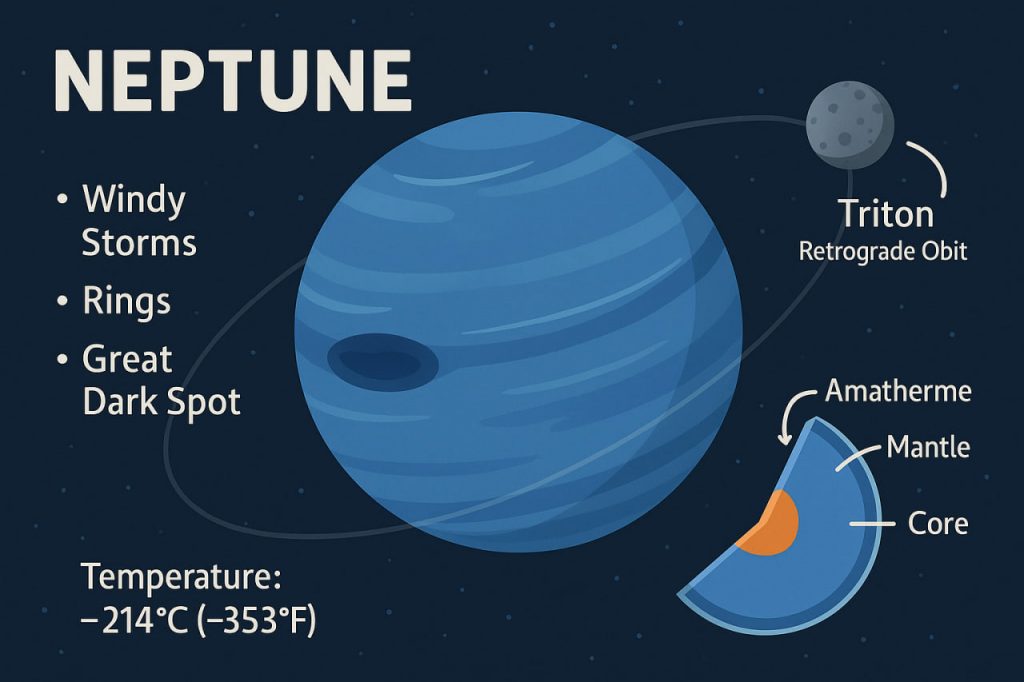Neptune is the eighth and farthest planet from the Sun in our Solar System. Known for its deep blue color and dynamic weather systems, Neptune is a gas giant and a fascinating world of high-speed winds, storms, and icy conditions. Though distant and cold, this remote planet continues to captivate scientists and astronomers.
Key Facts About Neptune
- Distance from the Sun: ~4.5 billion km (30 AU)
- Diameter: ~49,244 km (about 4 times wider than Earth)
- Length of day: 16 hours
- Length of year: 165 Earth years
- Surface temperature: Around -214°C (-353°F)
- Atmosphere: Mostly hydrogen, helium, and methane
- Moons: 14 known moons, including Triton
- Rings: 5 faint rings made of dust and ice particles
Why Is Neptune Blue?
Neptune’s vivid blue color comes from the presence of methane in its atmosphere. Methane absorbs red light and reflects blue, giving the planet its signature appearance. Interestingly, Neptune is bluer than Uranus even though both have methane, suggesting other unknown factors also influence its color.
A Planet of Powerful Storms
Neptune has the strongest winds in the Solar System, reaching speeds of up to 2,100 km/h (1,300 mph). These winds drive massive storms, including the once-observed Great Dark Spot, similar to Jupiter’s Great Red Spot. The dynamic atmosphere includes bands of clouds and rapidly moving storms.
Internal Structure
Neptune lacks a solid surface. Its internal structure includes:
- Atmosphere: Hydrogen, helium, and methane
- Mantle: Hot, dense water, ammonia, and methane ices
- Core: A rocky center, similar in size to Earth
The planet also emits more heat than it receives from the Sun, suggesting it has an internal heat source—a mystery still under investigation.
Triton: Neptune’s Largest Moon
Triton is unique because it orbits Neptune backward (retrograde motion), indicating it may be a captured object, possibly from the Kuiper Belt. Triton is geologically active, with ice volcanoes and a thin atmosphere.
Exploration of Neptune
So far, only one spacecraft, Voyager 2, has visited Neptune. In 1989, it performed a flyby, capturing the first close-up images of the planet and its moons. Future missions are being proposed to further explore Neptune and its system.
Importance of Studying Neptune
Neptune gives scientists insight into:
- Outer Solar System dynamics
- The behavior of ice giants
- The origins and evolution of planetary systems
- Exoplanets similar in size and composition to Neptune
Conclusion
Neptune is a cold, mysterious world filled with beautiful colors, extreme winds, and icy secrets. As technology advances, future missions may unlock the hidden stories of this remote planet and help us understand more about the universe.
Glossary
- Gas Giant: A large planet made mostly of gases like hydrogen and helium
- Methane: A gas that absorbs red light and reflects blue
- Retrograde Orbit: A moon’s orbit in the opposite direction of its planet’s rotation
- Ice Giant: A type of gas giant with more ices like water, ammonia, and methane
- Kuiper Belt: A region of icy bodies beyond Neptune’s orbit


